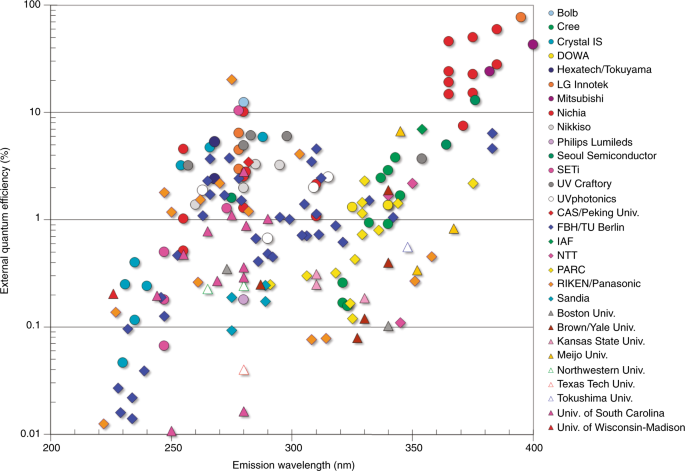In these uncertain times, there is increasingly persuasive evidence that “far-UV” radiation is effective in inactivating the SARS-CoV-2 virus and other pathogens, but without the health risks of germicidal ultraviolet radiation. Unfortunately, this technology has some of the hallmarks of a “miracle cure,” which has become an irresistible attractant for charlatans and hucksters of all stripes. Search the Web for “far-uv” products and you will find ultraviolet lamps, luminaires, sanitizer boxes, wands, water bottles, face masks, and more, all promising the miracle benefits of “far-uv” radiation. Look for investment opportunities online and you will find crowd-funded start-up companies clamoring to develop “far-uv” luminaires and air handling units. Search for ultraviolet germicidal irradiation (UVGI) products and you will find at least a few national companies who label every UVGI product in their catalog as “far-uv.” The reality is that very few of these products employ “far-uv” radiation sources. There is at present only one practical source of 222-nm UV-C radiation for germicidal applications: the krypton-chlorine excimer lamp. It is possible to manufacture light-emitting diodes with peak spectral emissions as low as 222 nm, but their radiant efficiency of slightly over 0.01 percent is abysmal (FIG. 1).

What is Far-UV?
One of the problems is that “far-UV” is not what you might think it is. Read the medical literature and you will find numerous references to “far-UV,” “far-UVC,” and “far ultraviolet,” all in reference to 222 nm (and occasionally 207 nm) ultraviolet radiation sources. Scholarly publications notwithstanding however, this is incorrect. The International Lighting Vocabulary (CIE 2011) defines:
- UV-A 315 – 400 nm
- UV-B 280 – 315 nm
- UV-C 100 – 280 nm
but with this footnote: “In some applications the ultraviolet spectrum has also been divided into “far,” “vacuum,” and “near” ultraviolet; however, the borders necessarily vary with the application (e.g. in meteorology, optical design, photochemistry, thermal physics, etc.).” These “some applications” include astronomy. Referring to ISO 21348:2007 (ISO 2007) regarding solar irradiances, we have:
- Vacuum ultraviolet 10 – 200 nm
- Extreme ultraviolet 10 – 120 nm
- Far ultraviolet 120 – 200 nm
- Ultraviolet C 100 – 280 nm
- Middle ultraviolet 200 – 300 nm
- Ultraviolet B 280 – 315 nm
- Near ultraviolet 300 – 400 nm
- Ultraviolet A 315 – 400 nm
The Illuminating Engineering Society follows the CIE subdivision of the ultraviolet spectrum (IES LS-1-20) under “ultraviolet subdivision,” but it also follows the ISO subdivision under “regions of the electromagnetic spectrum”:
- Extreme ultraviolet 10 – 120 nm
- Far ultraviolet 120 – 200 nm
- Middle ultraviolet 200 – 300 nm
- Near ultraviolet 300 – 400 nm
To be fair, the term “far ultraviolet” has previously defined in the academic literature to include 222-nm radiation. Forsyth et al. (1934), for example, defined:
- Far ultraviolet < 270 nm
- Middle ultraviolet 270 – 313.5 nm
- Near ultraviolet 313.5 – 400 nm
In other words, ultraviolet-C through ultraviolet-A respectively. Suffice it to say that the definition of “far ultraviolet” has been fluid over the years. Terminology matters. If we are to communicate effectively and unambiguously, we should respect the ISO definition of “far ultraviolet” as optical radiation with wavelengths between 120 nm and 200 nm, and refer to 222 nm radiation sources simply as ultraviolet-C emitters. Speaking of terminology, it is ultraviolet radiation, not “light.” Light, as defined by IES LS-1-20, is “radiant energy that is capable of exciting the retina and producing a visual sensation in humans,” with wavelengths ranging from approximately 380 to 780 nm (CIE 2018). Optical radiation, on the other hand, extends from 100 nm to 1,000 mm, which includes everything from ultraviolet-C (CIE UV-C) to far infrared (CIE IR-C). Marketing, however, will undoubtedly prevail. If 222-nm ultraviolet radiation sources become commercially important, it will be necessary to distinguish between these and the more common (and hazardous) 254-nm germicidal lamps. International standards notwithstanding, “far-UV” will be generally understood in the context of germicidal applications as optical radiation within the wavelength range of approximately 200 nm to 250 nm. References CIE. 2011. CIE S017/E:2011, International Lighting Vocabulary, Third Edition. Vienna, Austria; Commission Internationale de l’Eclairage. CIE. 2018. CIE 015:2018, Colorimetry, Fourth Edition. Vienna, Austria: CIE Central Bureau. Forsyth, W. E., et al. 1934. “Ultraviolet Source and their Radiation,” J. Optical Society of America 24(7):178-192. IES. 2020. ANSI/IES LS-1-20, Lighting Science: Nomenclature and Definitions for Illuminating Engineering. New York, NY: Illuminating Engineering Society. ISO. 2007. ISO 21348:2007, Space Environment (Natural and Artificial) – Process for Determining Solar Irradiances. Geneva, Switzerland: ISO Central Secretariat. Kneissl, M. 2020. “UV-LEDs: State-of-the-Art and Applications,” in The 2020 UV Emitter Roadmap, J. Physics D: Applied Physics 53:503001.

0 Comments